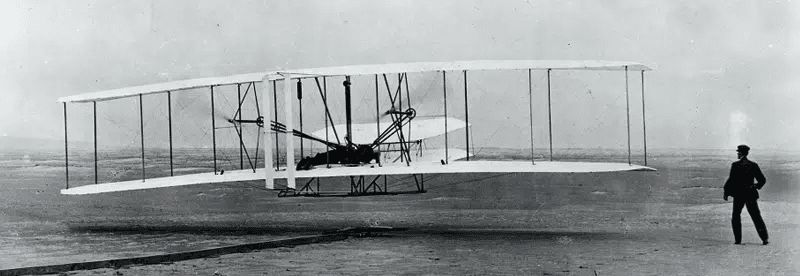The patent system receives a lot of criticism and it is not without its faults. But as a governmental program to advance technology, it’s hard to beat. To understand how it works and why investing in a well-drafted patent can help an organization reap significant rewards (or why a poorly drafted patent may fall on its face) consider this real-world example. Most of us attribute the birth of powered aviation to Wilbur and Orville Wright. The Wright brothers toiled for years using their understanding of mechanical design gained from their bicycle shop and examination of how birds fly to develop the first controllable, sustained-flight, heavier-than-air flying machine.
However, Wilbur and Orville were not just inventors, they were also businessmen and saw themselves as leaders in an entirely new industry. And just as inventors in cutting edge technology do today, they recognized the need to control and own the innovations they so painstakingly developed. They filed for a patent on their new machine and on May 22, 1906, U.S. Patent 821,393, to Wilbur and Orville Wright for “new and useful improvement in a Flying Machine,” was granted.
The patent documents their experiments of 1902 and how the Wrights succeeded in controlling their glider in all three axes of flight: pitch, roll, and yaw. Their breakthrough invention was the simultaneous use of roll control (with wing-warping) and yaw control (with a rear rudder). The original application, which they wrote themselves and filed in March of 1903, was rejected. In 1904, they hired Ohio patent attorney Henry Toulmin, and with his assistance were able to get legal protection for their invention.
A patent’s value rests in its claims and the ability of the application to support those claims. Indeed the claims define the metes and bounds of the inventor’s rights in their invention. In this case, the patent claimed a new and useful method of controlling a flying machine, powered or not. The technique of wing-warping was described, but the patent explicitly states that other means instead of wing-warping could be used for adjusting the outer portions of a machine’s wings to different angles on the right and left sides to achieve lateral roll control. The concept of lateral control was basic to nearly all airplane designs. Without it, aircraft generally could not be easily or safely controlled in flight. The Wright brothers’ approach was novel and, as we know, it worked.
Wilbur and Orville thought they had the market to themselves and as they expressed in one writing, “It is our view that morally the world owes its almost universal use of our system of lateral control entirely to us. It is also our opinion that legally it owes it to us.”
The Patent System: Designed to Promote Innovation
An interesting aspect of the patent system is that it is designed to promote innovation not stop it. And encourage innovation it did. Glenn Curtiss, founder of Curtiss Aviation, used ailerons to provide lateral control as compared to the wing warping described in the Wright patents. The Wright brothers felt that the Curtiss design infringed their patent and put the issue before a judge. The patent war that resulted from this claim explored the nuances of the claims, the depth of the description of the invention, and prior art. In the end, an agreement was reached to form a cross-license pool, or patent pool, to foster growth in aviation technology in light of World War I.
Ailerons where not new, by the way, as they existed as early as 1868. In a UK patent for gliders, Mathew Boulton described movable flaps found on the ends of the wings as a means to turn a glider. And while the judge considered this information, he dismissed it and commented, “Assertions and suggestions [of how ailerons could control an aircraft] were altogether too conjectural to teach others how to reduce them to, and therefore his patent is not anticipatory.”
The Wright brothers succeeded in defending their technology and later sold their rights to the Wright-Martin company, which you might know better as Lockheed Martin. Today, we don’t see many (or any) airplanes with wing warping. But it is hard to find an aircraft without ailerons. So did the Wright brothers’ patent enhance or stifle innovation? While there are advocates in each of those camps, it is clear that the patent kept the Wright’s in the center of aviation development. It also illustrates the importance then and today of a well-crafted patent application and an experienced legal team to support it.




